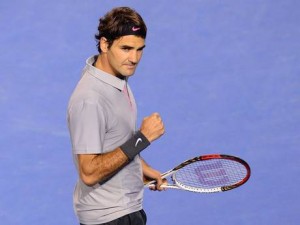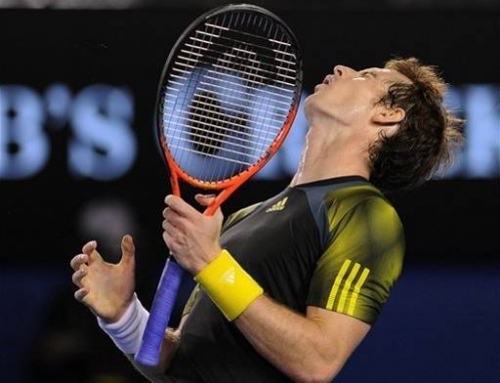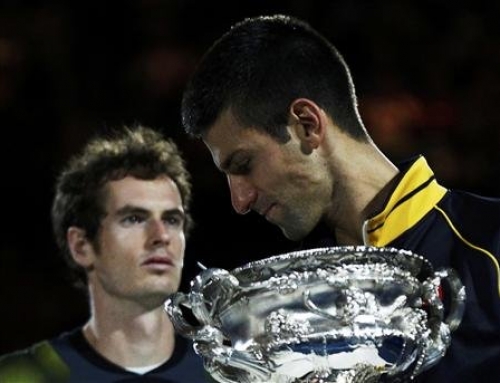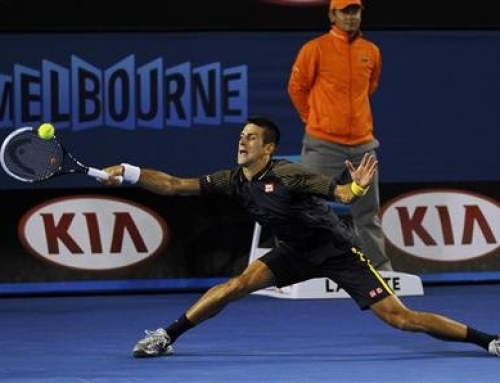 Let’s start with the earlier of the two quarterfinals played Wednesday in Melbourne.
Let’s start with the earlier of the two quarterfinals played Wednesday in Melbourne.
Andy Murray’s camp has complained that Roger Federer has had all the night matches. This is of concern because the Australian Open plays its semis and finals at night. Court conditions generally slow down when it gets cooler. All of Murray’s matches have been in the daytime. Tournament organizers have pointed out that Federer has just had the sexier match-ups, playing Davydenko (who was a runner-up in Doha and a former top 5 player) in the 2nd round, local fave, Bernard Tomic in the 3rd round, and up-and-comer, Milos Raonic in the 4th round while Murray has played Sousa in the second round, Berankis in the third round, and Simon in the fourth round.
Anyway, Murray’s quarterfinal opponent should have been Juan Martin del Potro, but instead, it was Jeremy Chardy. Chardy is ranked around 35 or so. He has a big serve, though it’s erratic (he double faults a lot), a huge forehand, and a nice backhand which he slices a lot. At the pro level, these weaknesses magnify themselves. Chardy was the fellow that Murray can credit for knocking del Potro out of the tournament. He backed that 5 set win with a win over steady Andreas Seppi.
This made Murray’s quarterfinal match perhaps the easiest, on paper, of the four being played. Still, Murray had yet to be challenged by a player that’s playing well, and although Chardy didn’t exactly play well, he hit enough hard shots that he made Murray work some. Murray had his best game of the tournament, something he acknowledged. Although the scores were lopsided once more, Murray was winning good rallies even as Chardy was hitting hard. Against Berankis, for example, Murray won cheap points when Berankis made silly errors, but Murray also made silly errors in rallies, and was unable to really control these exchanges, especially when he went for his shots. Against better players, Murray doesn’t have the luxury of missing.
You can see one aspect of Lendl’s influence. He wants Murray to win his early rounds quickly. While Murray tends to be efficient at the Australian Open, sometimes he finds himself in closer matches than expected. Over the years, he’s learned to win more quickly, but this year, he’s yet to drop a set, and has hardly been pushed to a 7-5 set (one against Berankis). Most players want to avoid what happened to Janko Tipsarevic who found himself in a 5-setter after being up 2 sets to love to Lukas Lacko, and then another 4 setter against Benneteau in the following round. He had to withdraw against Almagro. While Murray may be more fit, these are definitely situations a top player wants to avoid.
Murray started the match strongly with a 4-0 lead, but Chardy began attacking with his forehand, earned a break back. It was all Murray could do to stay that game ahead and win the first set, 64. Murray again started the second set with a break, but weathered the storm against Chardy’s attack. Murray was able to play enough shots to the Chardy backhand, then open up the court, and use his speed and his own forehand to win a fair number of rallies. This may prove useful against Federer who is unlikely to be quite this aggressive against Murray. The set ended badly for Chardy due to the fact that the Frenchman has one of the worst ball tosses of any top pro and was chasing his ball toss on a second serve and double-faulted.
The third set was pretty much the same as the first two with Murray again getting to early breaks. Murray was pretty much on cruise control, and threatened to break Chardy for a 61 win when Chardy managed to hold serve, but delayed the inevitable as Murray won the third set at 2.
Roger Federer had the decidedly harder semifinals, as Tsonga tested the Swiss as he tends to do. Much like the Wimbledon match that Federer lost to Tsonga 2 years ago, Federer won his sets in tiebreaks. Perhaps that experience of playing the Raonic tiebreak helped. Tsonga had breaks in the second and fourth set. The fifth set promised to be exciting but somehow Tsonga’s serve went away for a game, and he got broken. He nearly got broken again, but saved himself. In the fifth set, it ultimately came down to Federer just being more mentally focused in the match.
Commentators (I wasn’t up to see most of the match) said Federer’s serve and forehand were a bit off today, so he opted to play a lot of shots up the middle, and not be nearly as aggressive, and then play defense, something he may be doing to prep for Murray. Indeed, Federer seemed keen on hitting his backhand, and not running around it that much at the end of the match.
Federer said he would recover nicely for the semis, so he had no worries.






![[Aussie Open Final] Can Andy Murray beat Novak Djokovic?](https://www.essentialtennis.com/wp-content/uploads/2013/01/20130126andy-500x383.jpg)
![[Day 13, Aussie Open] Bryan brothers win 13th Slam with Aussie doubles title, Kyrgios wins boys title](https://www.essentialtennis.com/wp-content/uploads/2013/01/20130125bryan-500x383.jpg)